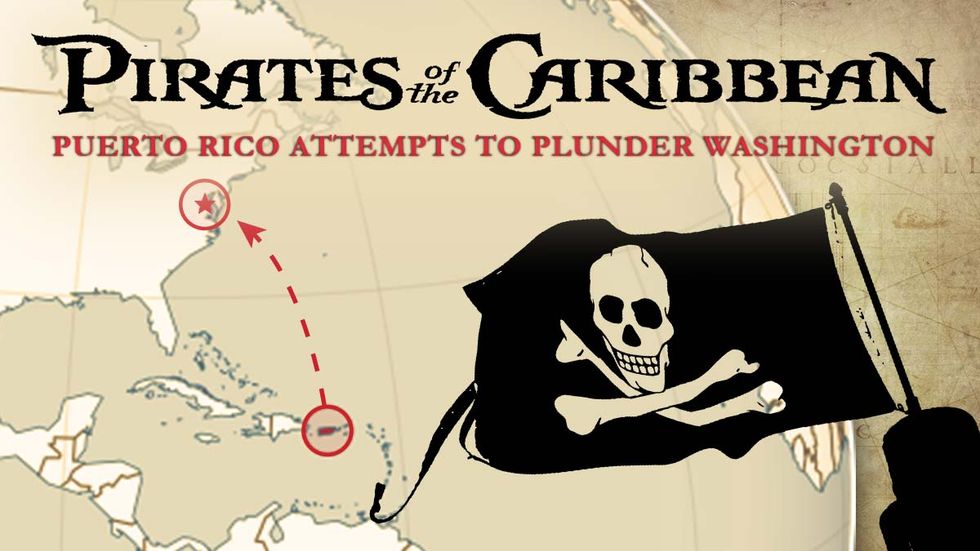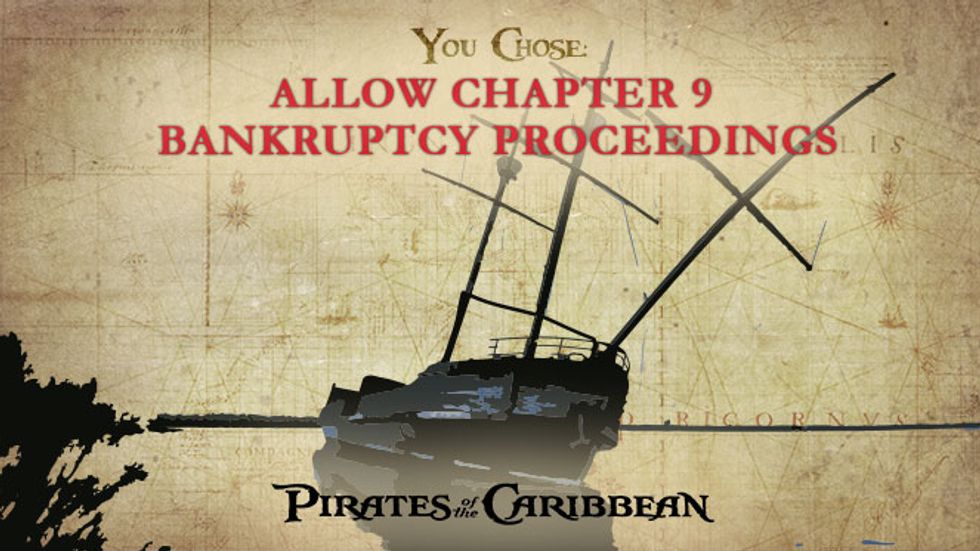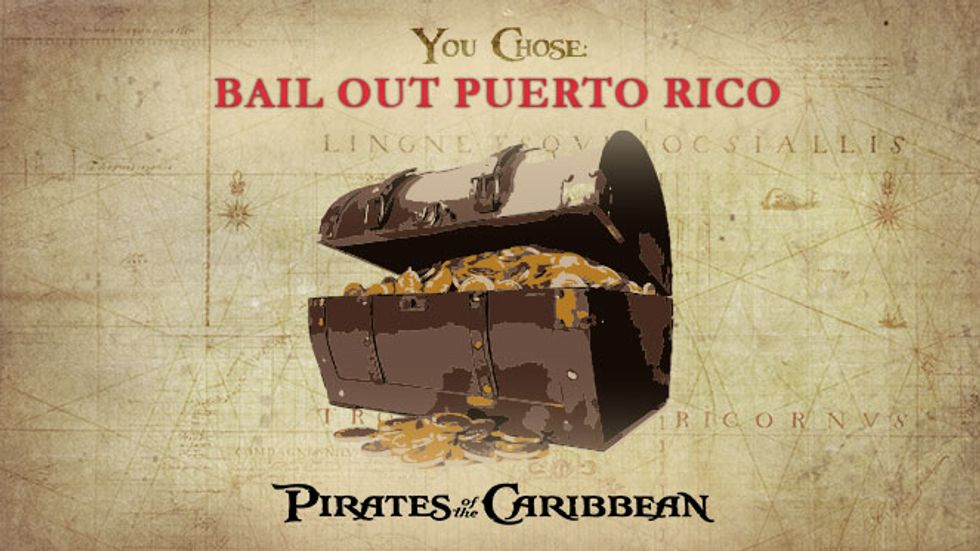
© 2024 Blaze Media LLC. All rights reserved.
Puerto Rico is a territory of the United States, nestled among the beautiful clear waters of the Caribbean. The archipelago became part of the United States during the Spanish-American war in 1898. Since then, the relationship between the U.S. and Puerto Rico has at times been tenuous. Puerto Rico on many occasions has requested Independence; the U.S. appeased the island by providing various economic incentives and expanded democratic liberties, such as the right to elect their own governor in 1947.
The economic giveaways and corrupt political cronyism allowed Puerto Rico to live beyond its means for decades. But the day of reckoning has finally arrived and Puerto Rico’s booty has been squandered. As viewed from the economic crow’s nest, financial ruin lays ahead.
The red-tape and overregulation of the island has eliminated jobs and increased welfare.
Flawed, Progressive Economics
Like the walk of a plank, all great progressive utopias built on bloated spending and bureaucracy ultimately come to an end. Puerto Rico’s unemployment rate has been stuck well beyond 10 percent since before the Great Recession. Today, it hovers above 12 percent. Puerto Rico has one of the lowest labor-participation rates in the west; less than half the population is working. Why? Well, it costs more to hire a worker in Puerto Rico that it does in some of the richest areas of the mainland United States. The minimum wage in Fresno, California is $9. However, the Puerto Rican minimum wage (which is enforced by Washington) is equivalent to 77 percent of the median wage of Puerto Rico, or $9.42 per hour.
The red-tape and overregulation of the island has eliminated jobs and increased welfare. Presently, nearly 35 percent of the island is on food stamps compared to only 15 percent of the population on the mainland.
Compounding Puerto Rico’s labor market woes is the fact that those who are employed are likely to be on the government dole. Nearly one in four people work for the government in Puerto Rico. That is, of course, when they are working. Puerto Rico government employees receive a European-competitive 30 days of vacation — and of course, must not be productive beyond eight hours per day — anything more costs the government time and a half.
Today, the island’s ability to attract business remains lackluster. According to the Heritage Foundation, the World Bank’s “Doing Business” index ranks the United States seventh out of 189 countries. Puerto Rico ranked 47th. And compared to other states within the U.S. boundaries, Puerto Rico ranks dead last in terms of economic output; the gross state product (GSP) from 2003 to 2013 was a negative 13.2 percent.
The New York Federal Reserve’s assessment is even sterner:
The Island appears to face two alternatives: either manage its own economic adjustment and put the Commonwealth on a secure fiscal basis, or wait for outmigration and the discipline of the market to force an even more painful adjustment.
Marxist Government Entities
There are many reasons for Puerto Rico’s malaise. The island’s internal policies have been mired in big government promises that were unreasonable, and their backward economic policies have left the nation unemployed and dependent on welfare. Puerto Rico’s debt has been headed toward Davy Jones’ Locker since at least the 1940s.
It was in the 1940s that Puerto Rico established the Government Development Bank (GDB). The GDB was created to be a fiscal adviser, and the government’s primary lender as well as to the island’s public corporations. Later, in the 1970s, the GDB began to establish subsidiaries, such as the Housing Finance Authority. This expansion of various subsidiaries continued until Puerto Rico created government entities and public corporations into nearly every sector of government and the economy.
It is this massive bureaucracy, and the public corporations in particular, that is responsible for most of the government’s debt. There are some 50 public corporations that operate similar to public agencies, and handle everything from public infrastructure, banking and real estate to insurance, health care, transportation, and electric (among much else).
The largest of these public corporations is the Puerto Rico Electric Authority (PREPA). PREPA holds more than $9 billion in debt, making it the largest issuer of the island’s $72 billion in debt. Until 2014, PREPA was self-regulated and operated like a monopoly; it resembled a Soviet-era entity with its total disregard for cost efficiencies, innovation, or modern business practices.
PREPA produces electricity at two-and-a-half times the cost of power plants on the mainland; and while it earns larger revenues than its counterparts, it remains in the red. The president of Puerto Rico’s Senate, Eduardo Bhatia even went so far as to state that, “Our power plants look like the cars in Cuba.” So far, PREPA has missed a $58 million scheduled payment in August 2015, and on January 1 it missed another scheduled payment of $163 million due on low-grade bonds.
According to Puerto Rico’s Center for a New Economy, multiple other public corporations are also insolvent. For instance, the Highway and Transportation Authority lacks the means to pay its debt of $2.2 billion, and investors believe that the Puerto Rico Aqueduct and Sewer Authority is in trouble too.
Washington hornswoggled Puerto Rico, too
According to an analysis by the Tax Foundation, there are a few other notable reasons Washington can share in the blame of Puerto Rico’s disaster. The blame begins with the tax code.
Among many artificial and distorted incentives, in 1976 Washington created something known as section 936 of the tax code. Essentially, Section 936 allowed Puerto Rico to become a tax haven for large business. First, it provided U.S. corporations with a tax exemption from income derived in Puerto Rico. Second, it eliminated all income tax liability of any corporate subsidiary (particularly foreign owned) that relocated to the island and distributed its profits as dividends. As a result, subsidiaries began paying the parent company in dividends at a huge tax windfall.
Section 936 “worked” — while it lasted. U.S. and foreign corporations flocked to Puerto Rico’s tax sanctuary, and the economy blossomed. However, this lucrative incentive in Puerto Rico was subject to the whims of Washington politicians. As the Tax Foundation puts it:
[P]uerto Rico grew rapidly during the 20th century and developed a substantial manufacturing sector, though it remained relatively poor compared to the U.S. mainland. However, because section 936 made foreign investment in Puerto Rico artificially attractive — creating, in effect, an economic bubble — it left the island vulnerable to a crash if the tax provisions were to ever be repealed.
That’s exactly what unfolded. The tax status granted by Washington became increasingly unpopular in the 1990s. As a result, President Clinton signed legislation in 1996 that phased out section 936 over a 10-year period. In 2006, exactly 10 years later, Puerto Rico’s economic downward spiral began.
Section 936 had a big impact on the well-being of Puerto Rico. However, another Washington-established tax provision may have done far more to contribute to Puerto Rico’s debt: the triple tax-exempt bond.
Here’s how it works: All municipals bonds are exempt from federal income taxes. Municipal bonds are also exempt from state and local taxes if you purchase those bonds from the location in which you reside—and only where you reside. This is referred to as “triple tax-exempt” bond status. However, if you purchase municipal bonds from another state, you are subject to taxation.
However, this does not apply to Puerto Rico. Investors get “triple tax-exempt” status regardless of where they live — a tax status that has made Puerto Rico very attractive to bond holders in high tax states like New York or California.
The unique status created a skewed incentive for Wall Street to purchase Puerto Rican debt. According to BloombergView, while the problems that plague Puerto Rico may not be the direct result of the triple tax exempt status, it is nevertheless fueling the fire. The tax free status allowed Puerto Rico to issue a unique bond that was attractive to investors; nearly 50 percent of all open-ended municipal bonds currently hold Puerto Rico’s debt. The result, according to BloombergView: “For Puerto Rico’s government, meanwhile, bonds came to look like hot credit cards — max one out, pay it down with another.”
As a result of such impressive fiscal mismanagement, Puerto Rico’s debt of $72 billion is equal to 100 percent of its economic output.
In other words, the triple tax-exempt status created enormous demand in the United States, which artificially lowered the bond yields that Puerto Rico would have to pay. Such cheap access to credit fostered a boom in debt among the island’s politicians — use debt to pay debt, repeat.
As a result of such impressive fiscal mismanagement, Puerto Rico’s debt of $72 billion is equal to 100 percent of its economic output. That total includes nearly $18 billion in principle and interest payments that are due to be paid over the next five years — enough to consume one out of every three dollars in revenues raised.
Furthermore, the $72 billion does not take into account another financial crisis looming within Puerto Rico: a $30 billion shortfall from an over-promised, underfunded public pension. As Bloomberg Business highlights:
The pension, which covers 119,975 employees, as of June 2014 had just 0.7 percent of the assets needed to pay all the benefits that had been promised, a level unheard of among U.S. States.
Puerto Rico has a small population of only 3.6 million people, nearly eleven times smaller than California. Yet, with $72 billion in debt, Puerto Rico nearly matches the Golden State’s state-funded debt of $97 billion.
Walt Disney’s beloved pirate, Jack Sparrow, from Pirates of the Caribbean, said it best: “The problem is not the problem. The problem is your attitude about the problem.”
Puerto Rican politicians’ attitudes are negligent—a total abdication of responsibility on behalf of Puerto Ricans. Here’s why: In February of 2014, the three major credit rating agencies downgraded Puerto Rico’s public debt to below investment grade. This was followed by repeated warnings: repeated downgrades in June 2014 and June 2015. Yet, in December of this year, the crooks running the U.S. territory still had the nerve to pay out $120 million in Christmas bonuses. Arrrrrrr!
The State of Play
This problem is a Puerto Rico problem. Many states have a statutory and constitutional guarantee on public-sector pensions as well as on public issued bonds. Puerto Rico is one of these. This is a Puerto Rican-created mess and, like other financially burdened states, it is a problem they must resolve.
But Washington is not resigned to let Puerto Rico fix its own problems. Instead, Republican Leadership has demanded that Congress draft legislation to facilitate the territory’s budgetary troubles.
Democrats have been in favor of a Chapter 9 bankruptcy proposal, a legal status not currently allowed to any state or Puerto Rico. Republicans, on the other hand, have offered a financial bailout, while President Obama is looking for all of the above — additional welfare, a bailout, and a modified Chapter 9 bankruptcy option. Puerto Rico is looking for a bailout; they are after yerrr money!
The ship is sailing, the waters will be rough, and the perfect storm may arise. But the right solution will allow the ship to tack windward, and sail to a safer harbor. Here are the various winds Congress is considering. Which route would you choose?
Want to leave a tip?
We answer to you. Help keep our content free of advertisers and big tech censorship by leaving a tip today.
Want to join the conversation?
Already a subscriber?
more stories
Sign up for the Blaze newsletter
By signing up, you agree to our Privacy Policy and Terms of Use, and agree to receive content that may sometimes include advertisements. You may opt out at any time.
© 2024 Blaze Media LLC. All rights reserved.
Get the stories that matter most delivered directly to your inbox.
By signing up, you agree to our Privacy Policy and Terms of Use, and agree to receive content that may sometimes include advertisements. You may opt out at any time.





